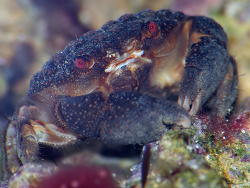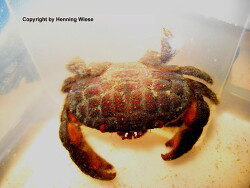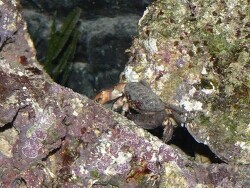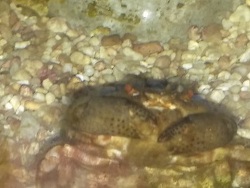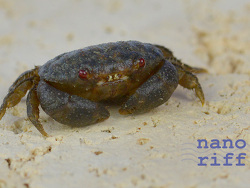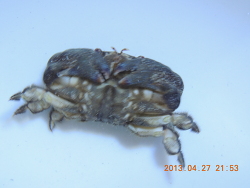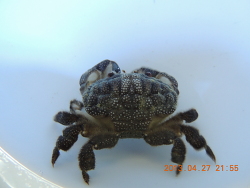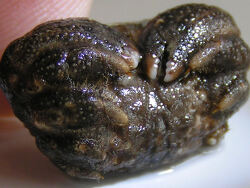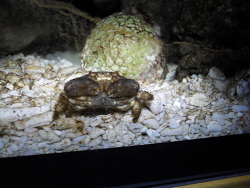Info
Actaeodes tomentosus (H. Milne Edwards, 1834)
(formerly listed as Paractea monodi)!
Lives on coral reefs in the intertidal zone. Often this species crab is introduced with live stones. In the past, most crabs were simply discarded because of the fear that they would attack and eat other animals (fish as well as invertebrates).It seems to be ensured that they also eat meat, but prefer mainly algae as food.
If you get such a crab, put it in the filter tank.The other way around, if it is a crab that has other animals on its menu, then you have to act and remove it.
Ollie: Has long been considered a Paractea monodi (Monod's round crab).
Reader Daniel reports observing his Actaeodes tomentosus catching fish.Since it is actually described as peaceful in the MWL, I thought I'd let you know.I was able to observe the crab grab a Stonogobiops nematodes as it retreated into its burrow and began eating it.
Note from crab expert Ollie : "Primarily they are likely to be algae and detritus eaters. In general, I'm sure they'll take anything that comes into their claws, but active hunters/predators they are not."
Poisonous to eat !
Many species of the family Xanthidae can be poisonous, although they themselves have no poisonous apparatus (poisonous teeth, poisonous spines, poisonous glands in the skin), the consumption of these crustaceans can even be fatal for humans. Such animals are considered passive-poisonous.
The toxins of crabs (saxitoxin and tetrodotoxin) are produced by endobacteria and stored in the flesh of the crab, these e are highly potent and similar to the neurotoxins of puffer fish and just as deadly.
In its raw and cooked meat, consumption of the crab meat is toxic to humans!
Please be sure to clarify whether the meat of these crabs is toxic or non-toxic before eating it!
Call an emergency doctor immediately at the first signs of poisoning (e.g. breathing problems, muscle cramps)!
The good news is there’s no way you can be exposed to these toxins if you don’t try to eat these crabs – a bite or a jab isn’t going to do the job.
The bad news for those who unwittingly consume these crabs is that cooking the meat isn’t going to make the toxins any less effective.
Fortunately, toxic crabs don’t want to be eaten just as much as we shouldn’t be eating them, so they help us out with their glorious warning colours.
Synonyms:
Actaea tomentosa (H. Milne Edwards, 1834)
Zozymus tomentosus H. Milne Edwards, 1834
(formerly listed as Paractea monodi)!
Lives on coral reefs in the intertidal zone. Often this species crab is introduced with live stones. In the past, most crabs were simply discarded because of the fear that they would attack and eat other animals (fish as well as invertebrates).It seems to be ensured that they also eat meat, but prefer mainly algae as food.
If you get such a crab, put it in the filter tank.The other way around, if it is a crab that has other animals on its menu, then you have to act and remove it.
Ollie: Has long been considered a Paractea monodi (Monod's round crab).
Reader Daniel reports observing his Actaeodes tomentosus catching fish.Since it is actually described as peaceful in the MWL, I thought I'd let you know.I was able to observe the crab grab a Stonogobiops nematodes as it retreated into its burrow and began eating it.
Note from crab expert Ollie : "Primarily they are likely to be algae and detritus eaters. In general, I'm sure they'll take anything that comes into their claws, but active hunters/predators they are not."
Poisonous to eat !
Many species of the family Xanthidae can be poisonous, although they themselves have no poisonous apparatus (poisonous teeth, poisonous spines, poisonous glands in the skin), the consumption of these crustaceans can even be fatal for humans. Such animals are considered passive-poisonous.
The toxins of crabs (saxitoxin and tetrodotoxin) are produced by endobacteria and stored in the flesh of the crab, these e are highly potent and similar to the neurotoxins of puffer fish and just as deadly.
In its raw and cooked meat, consumption of the crab meat is toxic to humans!
Please be sure to clarify whether the meat of these crabs is toxic or non-toxic before eating it!
Call an emergency doctor immediately at the first signs of poisoning (e.g. breathing problems, muscle cramps)!
The good news is there’s no way you can be exposed to these toxins if you don’t try to eat these crabs – a bite or a jab isn’t going to do the job.
The bad news for those who unwittingly consume these crabs is that cooking the meat isn’t going to make the toxins any less effective.
Fortunately, toxic crabs don’t want to be eaten just as much as we shouldn’t be eating them, so they help us out with their glorious warning colours.
Synonyms:
Actaea tomentosa (H. Milne Edwards, 1834)
Zozymus tomentosus H. Milne Edwards, 1834







 BEASTIEPENDENT
BEASTIEPENDENT







